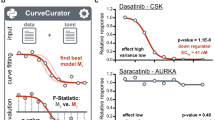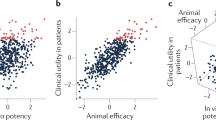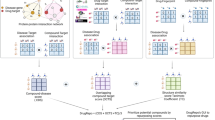Abstract
Drug discovery is extremely difficult. There are many unanticipated scientific, medical and business challenges to every drug discovery programme. It is important to increase our understanding of the fundamental properties of effective drugs so that we can anticipate potential problems in developing new agents. This article addresses potential drug discovery and development risks associated with the biochemical mechanism of drug action, and proposes simple rules to minimize these risks.
This is a preview of subscription content, access via your institution
Access options
Subscribe to this journal
Receive 12 print issues and online access
$209.00 per year
only $17.42 per issue
Buy this article
- Purchase on Springer Link
- Instant access to full article PDF
Prices may be subject to local taxes which are calculated during checkout



Similar content being viewed by others
References
Hopkins, A. L., & Groom, C. R. The druggable genome. Nature Rev. Drug Discov. 1, 727?730 (2002).
Cheng, Y. -C., & Prusoff, W. H. Relationship between the inhibition constant (KI) and the concentration of inhibitor which causes 50 per cent inhibition (IC50) or an enzymatic reaction. Biochem. Pharm. 22, 3099?3108 (1973).
Westley, A. M. & Westley J. Enzyme inhibition in open systems. Superiority of uncompetitive agents. J. Biol. Chem. 271, 5347?5352 (1996).
Roth, G. J. & Majerus, P. W. The mechanism of the effect of aspirin on human platelets. I. Acetylation of a particulate fraction protein. J. Clin. Invest. 56, 624?632 (1975).
Wallmark, B., Brandstrom, A. & Larsson, H. Evidence for acid-induced transformation of omeprazole into an active inhibitor of (H+/K+)-ATPase within the parietal cell. Biochim. Biophys. Acta 778, 549?558 (1984).
Sachs, G., Shin, J. M., Briving, C., Wallmark, B. & Hersey, S. The pharmacology of the gastric acid pump: the H+,K+ ATPase. Annu. Rev. Pharmacol. Toxicol. 35, 277?305 (1995).
Brown, R. P., Aplin, R. T. & Schofield, C. J. Inhibition of TEM-2 β-lactamase from Escherichia coli by clavulanic acid: observation of intermediates by electrospray ionization mass spectrometry. Biochemistry 35, 12421?12432 (1996).
Therrien, C., Kotra, L. P., Sanschagrin, F., Mobashery, S. & Levesque, R. C. Evaluation of inhibition of the carbenicillin-hydrolyzing β-lactamase PSE-4 by the clinically used mechanism-based inhibitors. FEBS Let. 470, 285?292 (2000).
Therapeutic Drugs 2nd edn (ed. Dollery, C.) T16?T20 (Churchill Livingston Edinburgh, 1999).
Laux G., Volz, H. P. & Moller, H. J. Newer and older monoamine oxidase inhibitors: a comparative profile. CNS Drugs 3, 145?158 (1995).
Angehagen, M., Ben-Menachem, E., Ronnback, L. & Hansson, E. Novel mechanisms of action of three antiepileptic drugs, vigabatrin, tiagabine, and topiramate. Neurochem. Res. 28, 333?340 (2003).
Bull, H. G. et al. Mechanism-based inhibition of human steroid 5α-reductase by finasteride: enzyme-catalyzed formation of NADP-dihydrofinasteride, a potent bisubstrate analog inhibitor. J. Am. Chem. Soc. 118, 2359?2365 (1996).
Brodie, A. M. H., Wing, L. Y., Goss, P., Dowsett, M. & Coombes, R. C. Aromatase inhibitors and the treatment of breast cancer. J. Steroid Biochem. 24, 91?97 (1986).
Walker, M. C. et al. A three-step kinetic mechanism for selective inhibition of cyclooxygenase-2 by diarylheterocyclic inhibitors. Biochem. J. 357, 709?718 (2001)
Hood, W. F. et al. Characterization of celecoxib and valdecoxib binding to cyclooxygenase. Mol. Pharmacol. 63, 870?877 (2003).
Bar-on, P. et al. Kinetic and structural studies on the interaction of cholinesterase with the anti-Alzheimer drug rivastigmine. Biochemistry 41, 3555?3564 (2002).
So, O. -Y., Scarafia, L. S., Mak, A. Y., Callan, O. H. & Swinney, D. C. The dynamics of prostaglandin H synthases. Studies with prostaglandin H synthase 2 Y355F unmask mechanisms of time-dependent inhibition and allosteric activation. J. Biol. Chem. 273, 5801?5807 (1998).
Copeland, R. A. et al. Mechanism of selective inhibition of the inducible isoform of prostaglandin G/H synthase. Proc. Natl Acad. Sci. USA 91, 11202?11206 (1994).
Vauquelin, G., Van Liefde, I., Birzbier, B. B. & Vanderheyden, P. M. L. New insights in insurmountable antagonism. Fundam. Clin. Pharmacol. 16, 263?272 (2002).
Fierens, F. L. P. et al. Tight binding of angiotensin AT1 receptor antagonist 3H-candesartan is independent of receptor internalization. Biochem. Pharmacol. 61, 1227?1235 (2001).
Maillard, M. P. et al. In vitro and in vivo characterization of the activity of telmisartan: an insurmountable angiotensin II receptor antagonist. J. Pharmacol. Exp. Ther. 302, 1089?1095 (2002).
Anthes, J. C. et al. Biochemical characterization of desloratadine, a potent antagonist of the human histamine H1 receptor. Euro. J. Pharmacol. 449, 229?237 (2002).
Steinmetz, A. C. U., Renaud, J. -P. & Moras, D. Binding of ligands and activation of transcription by nuclear receptors. Annu. Rev. Biophys. Biomol. Struct. 30, 329?359 (2001).
Dennis, A. P., Haq, R. U. I. & Nawaz, Z. Importance of the regulation of nuclear receptor degradation. Front. Biosci. 6, 954?959 (2001).
Waller, A. S., Sharrard, R. M., Berthon, P. & Maitland, N. J. Androgen receptor localisation and turnover in human prostate epithelium treated with the antiandrogen, casodex. J. Mol. Endocrin. 24, 339?351 (2000).
McDonnell, D. P. The molecular pharmacology of SERMs. Trends Endocrin. Metabol. 10, 301?311 (1999).
Fagart, J. et al. Antagonism in the human mineralocorticoid receptor. EMBO J. 17, 3317?3325 (1998).
Fleckenstein, A. Specific pharmacology of calcium in myocardium, cardiac pacemakers, and vascular smooth muscle. Annu. Rev. Pharmacol. Tox. 17, 149?166 (1977).
Lee, K. S. & Tsien, R. W. Mechanism of calcium channel blockade by verapamil, D600, diltiazem and nitrendipine in single dialysed heart cells. Nature 302, 790?794 (1983).
Johnson, B. D., Hockerman, G. H., Scheuer, T. & Catterall, W. A. Distinct effects of mutations in transmembrane segment IVS6 on block of L-type calcium channels by structurally similar phenylalkylamines. Mol. Pharmacol. 50, 1388?1400 (1996).
Catterall, W. A. Molecular properties of brain sodium channels: an important target for anticonvulsant drugs. Adv. Neurol. 79, 441?456 (1999).
Kuo, C. -C. & Bean, B. P. Slow binding of phenytoin to inactivated sodium channels in rat hippocampal neurons. Mol. Pharmacol. 46, 716?725 (1994).
Lewis, H. D., Davis, J. W. & Archibald, D. G. Protective effects of aspirin against acute myocardial infarction and death in men with unstable angina. New Eng. J. Med. 309, 396?403 (1983).
Blower, P. R. Granisetron: relating pharmacology to clinical efficacy. Support Care Cancer 11, 93?100 (2003).
Van Noord, J. A., Smeets, J. J., Custers, F. L. J., Korducki, L. & Cornelissen, P. J. G. Pharmacodynamic steady state of tiotropium in patients with chronic obstructive pulmonary disease. Eur. Respir. J. 19, 639?644 (2002).
Kapur, S. & Seeman, P. Does fast dissociation from the dopamine D2 receptor explain the action of atypical antipsychotics?: a new hypothesis. Am. J. Psychiatry 158, 360?369 (2001).
Rabinowitz, J. D., Beeson, C., Lyons, D. S., Davis, M. M. & McConnell, H. M. Kinetic discrimination in T-cell activation. Proc. Natl. Acad. Sci. USA 93, 1401?1405 (1996).
Savage, P. A., Boniface, J. J. & Davis, M. M. A kinetic basis for T-cell receptor repertoire selection during an immune response. Immunity 10, 485?492 (1999).
Liu, X. & Bosselut, R. Duration of TCR signaling controls CD4-CD8 lineage differentiation in vivo. Nature Immunol. 5, 280?288 (2004).
Bjork, I., Nordling, K., Larsson, I. & Olson, S. T. Kinetic characterization of the substrate reaction between a complex of antithrombin with a synthetic reactive-bond loop tetradecapeptide and four target proteinases of the inhibitor. J. Biol. Chem. 267, 19047?19050 (1992).
Stone, S. R. & Hermans, J. M. Inhibitory mechanism of serpins. Interaction of thrombin with antithrombin and protease nexin I. Biochemistry 34, 5164?5172 (1995).
Cunningham, E. L., Jaswal, S. S., Sohl, J. L. & Agard, D. A. Kinetic stability as a mechanism for protease longevity. Proc. Natl Acad. Sci. USA 96, 11008?11014 (1999).
Rindeau, D. et al. Comparison of the cyclooxygenase-1 inhibitory properties of nonsteroidal anti-inflammatory drugs (NSAIDs) and selective COX-2 inhibitors using sensitive microsomal and platelet assays. Can. J. Physiol. Pharmacol. 75, 1088?1095 (1997).
Fierens, F., Vanderheyden, P. M. L., De Backer, J. -P. & Vauquelin, G. Binding of the antagonist [3H]candesartan to angiotensin II AT1 receptor-transfected Chinese hamster ovary cells. Eur. J. Pharmacol. 367, 413?422 (1999).
Garcha, R. S., Sever, P. S. & Hughes, A. D. Action of AT1 receptor antagonists on angiotensin II induced tone in human isolated subcutaneous resistance arteries. Br. J. Pharmacol. 127, 1876?1882 (1999).
Bernhart, C. A. et al. A new series of imidazolones: highly specific and potent nonpeptide AT1 angiotensin II receptor antagonists. J. Med. Chem. 36, 3371?3380 (1993).
Cazaubon, C. et al. Pharmacological characterization of SR 47436, a new nonpeptide AT1 subtype angiotensin II receptor antagonist. J. Pharmacol. Exp. Ther. 265, 826?834 (1993).
Criscione, L. et al. Pharmacological profile of valsartan: a potent, orally active, nonpeptide antagonist of the angiotensin II AT1-receptor subtype. Br. J. Pharmacol. 110, 761?771 (1993).
Wienen, W. et al. Pharmacological characterization of the novel nonpeptide angiotensin II receptor antagonist, BIBR 277. Br. J. Pharmacol. 110, 245?252 (1993).
Edwards, R. M. et al. Pharmacological characterization of the nonpeptide angiotensin II receptor antagonist, SF&F 108566. J. Pharmacol. Exp. Ther. 260, 175?181 (1992).
Corsini, A., Maggi, F. M. & Catapano, A. L. Pharmacology of competitive inhibitors of HMG-CoA reductase. Pharm. Rev. 31, 9?27 (1995).
Haddad, E. -B., Mak, J. C. W. & Barnes, P. J. Characterization of [3H]Ba 679, a slow-dissociating muscarinic receptor antagonist in human lung: radioligand binding and autoradiographic mapping. Mol. Pharmacol. 45, 899?907 (1994).
Nilvebrant, L., Hallen, B. & Larsson, G. Tolerodine ? a bladder selective muscarinic receptor antagonist: preclinical pharmacology and clinical data. Life Sci. 60, 1129?1136 (1997).
Nayler, W. G. & Gu, X. H. (-)[3H]Amlodipine binding to rat cardiac membranes. J. Cardiovasc. Pharmacol. 17, 587?592 (1991).
Sun, J. & Triggle, D. J. Calcium channel antagonists: cardiovascular selectivity of action. J. Pharmacol. Exp. Ther. 274, 419?426 (1995).
Kemppainen, J. A. et al. Distinguishing androgen receptor agonists and antagonists: distinct mechanisms of activation by medroxyprogesterone acetate and dihydrotestosterone. Mol. Endocrinol. 13, 440?454 (1999).
Kraft, K. S., Ruenitz, P. C. & Bartlett, M. G. Carboxylic acid analogues of tamoxifen: (Z)-2[p-(1,2-diphenyl-a-butenyl)phenoxy]-N,N-dimethylethylamine. Estrogen receptor affinity and estrogen antagonist effects in MCF cells. J. Med. Chem. 42, 3126?3133 (1999).
Miller, C. P. et al. Design, synthesis, and preclinical characterization of novel, highly selective indole estrogens. J. Med. Chem. 44, 1654?1657 (2001).
Couette, B., Lombes, M., Baulieu, E. -E. & Rafestin-Oblin, M. -E. Aldosterone antagonists destabilize the mineralocorticosteroid receptor. Biochem. J. 282, 697?702 (1992).
Massaad. C., Lombes, M., Aggerbeck, M., Rafestin-Oblin, M. -E. & Barouki, R. Cell-specific, promoter-dependent mineralocorticoid agonist activity of spironolactone. Mol. Pharmacol. 51, 285?297 (1996).
Edwards, D. E. et al. Progesterone receptor and the mechanism of action of progesterone antagonists. J. Steroid Biochem. Mol. Biol. 53, 449?458 (1995).
Hill, E. E., Husbands, D. R. & Lands, W. E. M. The selective incorporation of 14C-glycerol into different species of phosphatidic acid, phosphatidylethanolamine, and phosphatidylcholine. J. Biol. Chem. 243, 4440?4451 (1968).
Carter, G. W. et al. 5-Lipoxygenase inhibitory activity of Zileuton. J. Pharmacol. Exp. Ther. 256, 929?937 (1990).
Krell, R. D. et al. The preclinical pharmacology of ICI 204,219. A peptide leukotriene antagonist. Am. Rev. Respir. Dis. 141, 978?987 (1990).
Acknowledgements
The author wishes to thank E. Sjogren and D. Chen for many interesting discussions.
Author information
Authors and Affiliations
Ethics declarations
Competing interests
D.C.S. is employed by Roche Pharmaceuticals.
Related links
Related links
DATABASES
Entrez Gene
Online Mendelian Inheritance in Man
Rights and permissions
About this article
Cite this article
Swinney, D. Biochemical mechanisms of drug action: what does it take for success?. Nat Rev Drug Discov 3, 801–808 (2004). https://doi.org/10.1038/nrd1500
Issue Date:
DOI: https://doi.org/10.1038/nrd1500
This article is cited by
-
A miniaturized mode-of-action profiling platform enables high throughput characterization of the molecular and cellular dynamics of EZH2 inhibition
Scientific Reports (2024)
-
Lactate regulates cell cycle by remodelling the anaphase promoting complex
Nature (2023)
-
Prospective dietary radical scavengers: Boon in Pharmacokinetics, overcome insulin obstruction via signaling cascade for absorption during impediments in metabolic disorder like Diabetic Mellitus
Journal of Diabetes & Metabolic Disorders (2022)
-
Heterologous expression of a papain-like protease inhibitor (SnuCalCpI17) in the E. coli and its mode of inhibition
Applied Microbiology and Biotechnology (2022)
-
Selective inhibition of aldo-keto reductase 1C3: a novel mechanism involved in midostaurin and daunorubicin synergism
Archives of Toxicology (2021)



